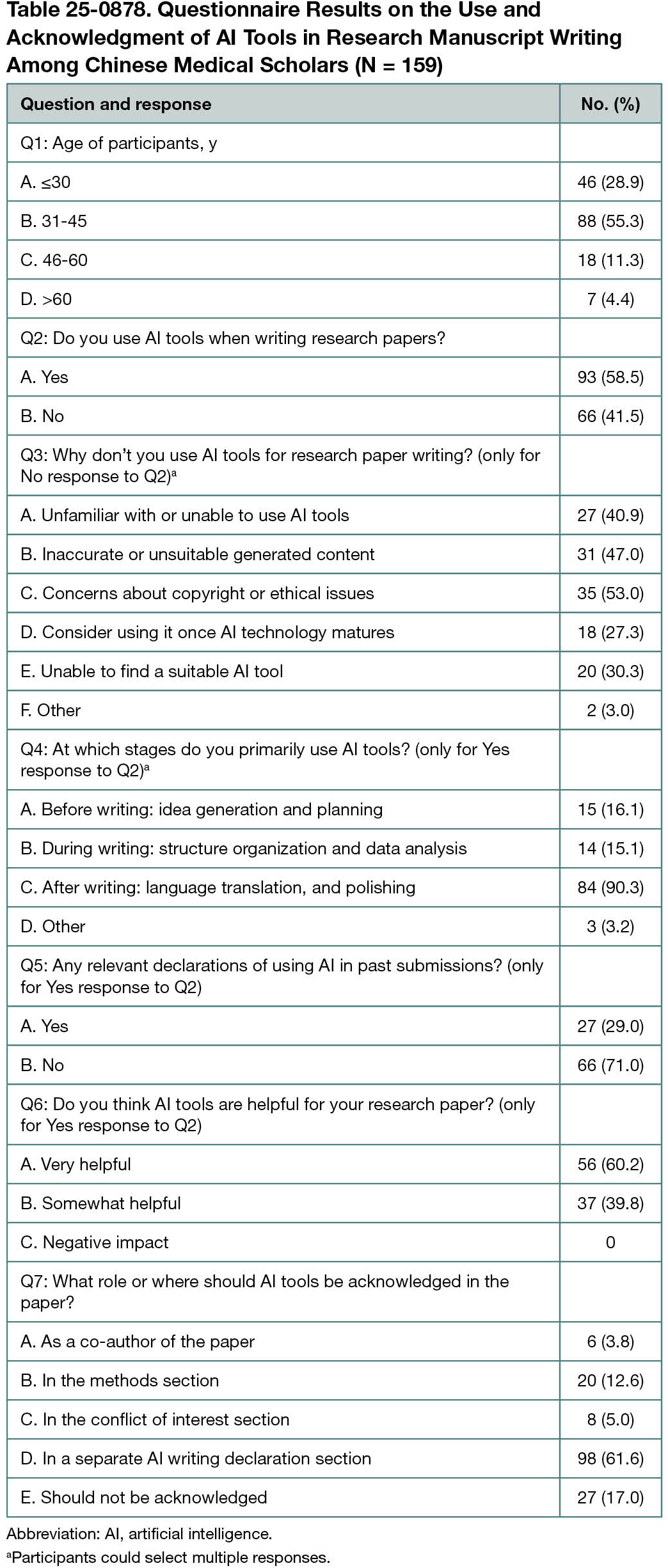Abstract
Artificial Intelligence Use and Acknowledgment in Medical Research Writing Among Chinese Scholars
Yang Zhang,1,2 Mengyuan Duan,1,2 Guoguang Zhao,3 Penghu Wei,2,3 Xiuyuan Hao4
Objective
Given the increasing role of artificial intelligence (AI) in academic writing, it is important to understand how these tools are integrated into research practices. This study aimed to explore the use of AI in academic writing by Chinese medical scholars and to identify potential factors influencing their adoption and perceptions of AI.
Design
A total of 378 peer reviewers of Chinese Medical Journal were invited to participate in a survey using an electronic questionnaire via email between January 2, 2025, and January 12, 2025. The questionnaire included questions about AI tool use in research paper writing, reasons for nonuse, stages of use, experience of declaration, and perception of effects of AI use. The survey also explored what role AI should have and where researchers believe AI should be acknowledged in publications. The Fisher exact test was used to identify significant differences between subgroups based on age and use.
Results
Of the 378 reviewers invited, 159 (42.1%) provided valid responses. Among the respondents, 93 (58.5%) reported using AI tools in their research paper writing, and 66 (41.5%) did not (Table 25-0878). There was a significant difference in declared use of AI across age groups, with younger researchers more likely to use AI tools (76.1% of those ≤30 years, 59.1% of those 31-45 years, 27.8% of those 46-60 years, and 14.3% of those >60 years; P < .001). The primary reasons for not using AI tools included copyright or ethical issues (53.0%), concerns about inaccuracy (47.0%), and unfamiliarity with AI tools (40.9%). Notably, there were still 27.3% non-AI users considering using AI when technology matures. The most common stages at which AI tools were used was after writing for language translation and polishing (90.3%), followed by idea generation before writing (16.1%) and structural organization during writing (15.1%). However, only 29.0% of participants declared AI use in past submissions. A total of 60.2% found the tools to be very helpful, while none considered them to have negative impact. The preferred roles and acknowledgement of AI tools in papers included a separate AI writing declaration section (61.6%), not acknowledging AI at all (17.0%), reporting in the methods section (12.6%), reporting in the conflict of interest section (5.0%), and including AI as a co-author (3.8%), which did not significantly differ between AI users and nonusers; nor did these views differ significantly by age.
Conclusions
In this study, nearly 60% of Chinese medical scholars reported use of AI tools in writing and preparing papers, particularly for language translation and polishing. However, many reported concerns about the accuracy, ethics, and maturity of AI technology. Current AI guidelines in academic publishing lack a unified standard, particularly in usage scope and enforcement. Some journals lack mandatory disclosure policies for AI use, standardized templates for reporting, or requirements to submit archival copies of original data or content before AI use, which might account for incomplete reporting or failure to report use of AI. Further research is needed to assess the long-term impact of AI on academic writing.
1National Center for Neurological Disorders, Xuanwu Hospital Capital Medical University, Beijing, China; 2Editorial Office, Brain Network Disorders, Xuanwu Hospital Capital Medical University, Beijing, China; 3Department of Neurosurgery, Xuanwu Hospital Capital Medical University, Beijing, China; 4Editorial Office, Chinese Medical Journal, Chinese Medical Association Publishing House, Beijing, China, haoxiuyuan@cma.org.cn.
Conflict of Interest Disclosures
None reported.
AdditionaI Information
ChatGPT (version GPT-4o mini; OpenAI) was used on January 20, 2025, for language translation, grammar checking, and manuscript polishing to ensure the clarity and coherence of this abstract.

